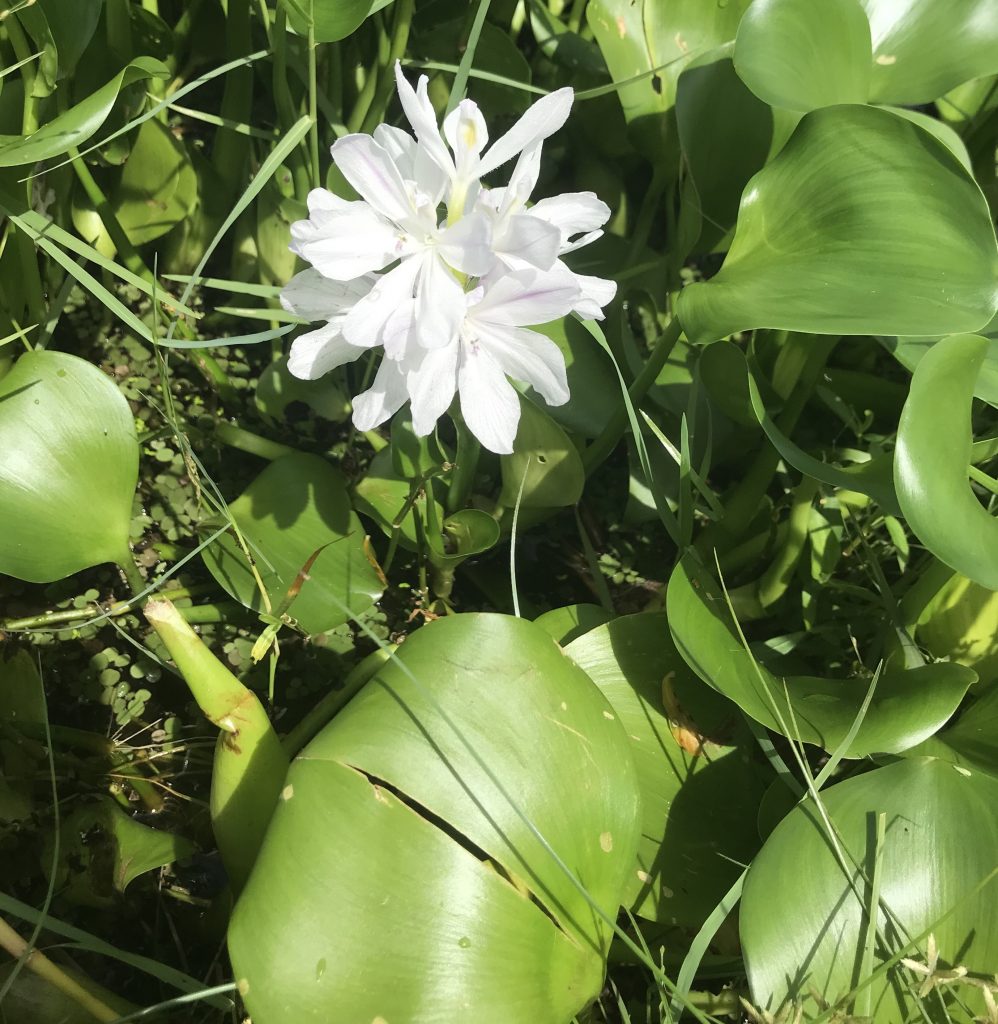
Water Hyacinths are usually blue with a gold spot. Photo by Green Deane.
A white Water Hyacinth was seen recently in the Little Econ River east of Orlando. Is this a beginning of a new subspecies for the much-hated edible? It’s doubtful you will find any plant organization on earth that thinks favorably of Eichhornia crassipes (aka Pontederia crassipes.) It tends to clog every waterway it is found in. It’s been jamming Florida rivers since 1876. One solution never floated in North America is to eat it. In my book that is scheduled to be released in the spring of 2023 I write:
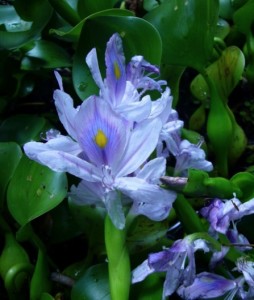
Water Hyacinths are usually on the light blue side. Photo by Green Deane
Analysis of the leaves showed potassium 44.5%, calcium 19.5%, chlorine 16%, phosphorus 6.5%, magnesium 5%, silicon 2%, sulphur 1.5%, sodium 1%, and manganese 0.7%. Those are a lot of the things our body can use. The stems had slightly less and roots far less. We also know a few other things. A feeding trial with sheep reported the leaves were 14.4% crude protein. Another said it the protein content was comparable to cottonseeds and soybeans. A third reported the plant is 6.7% fiber and 5.5% lipids the prime ones being palmitic in the leaves but linolenic and linoleic in the flowers. Lastly a patent was filed in 2004 for a new process to extract high amounts of beta-carotene from Water Hyacinth. Beta-carotene is what the body turns into vitamin A. We may not have a traditional nutritional line-up here but we know it’s edible and good for us.
If you are going to eat Water Hyacinth it is recommended you 1) get it from pristine waters and 2) cook it. Even with cooking it can give some folks a niacin-like itch.
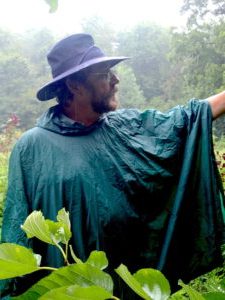
Classes are held rain or shine (but not during hurricanes.)
Foraging Classes: Long-range forecasts say we don’t have to worry about tropical storms for a couple of week so there’s only hot weather to concern us.
Saturday August 28th, Boulware Springs Park, 3420 SE 15th St., Gainesville, FL 32641. Meet at the picnic tables next to the pump house. 9 to noon.
Sunday August 29th, Mead Garden: 1500 S. Denning Dr., Winter Park, FL 32789. Meet at the bathrooms. 9 a.m to noon.
Saturday September 4th, Red Bug Slough Preserve, 5200 Beneva Road, Sarasota, FL, 34233. 9 a.m. to noon.
Sunday September 5th, Wickham Park: 2500 Parkway Drive, Melbourne, FL 32935-2335. 9 a.m. to noon. Meet at the dog park.
October 9th and 10th, Honea Path, South Carolina, 9 a.m. and 1 p.m. each day.
For more information, to pre-pay or sign go here.
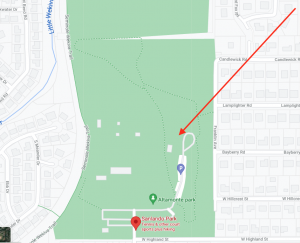
Location of a substantial fruiting of wild grapes.
During our foraging class last Sunday in Altamonte springs at Sanlando Park we came upon a large amount of muscadine grapes. They were also quite ripe. We usually recommend looking for wild grapes around the first of September though they can be as early as late July and in fact one can find them sporadically in small amounts almost any time of year. However they favor now. There were enough to mention them on Facebook and include the screen shot of the location (right.) Despite their sweetness grapes, like tomatoes, can hide much acid with sugar. It is always best to try one or two and wait a while to see if the acid content irritates your throat a little. If you are going to harvest these you will need a long stick with a cutting end or a ladder.
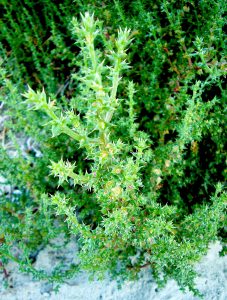
I find Russian Thistles in front of hotels on Daytona Beach. Photo by Green Deane
We shouldn’t forage along railroad tracks and you can blame it all on the Russian Thistle. This species, best known as the tumble weed that rolls across the wild west in movies, came with immigrants to southern South Dakota in the early 1870’s. Best guess is it contaminated their flax seed. By 1895 it reached New Jersey and California. The question was how? A professor who worked for the Department of Agriculture figured out the trains were spreading the seeds coast to coast. It was a remarkable idea at the time and brought him much fame. His solution to the unintentional distribution? Kill plants long railroad tracks. Thus began the practice of putting down some mighty and long-lasting chemicals to kill weeds sprouting amongst the iron rails. Railroad tracks are a good place to find seeds to take home and plant but not to find food. There have even been a few reported deaths from foraging along rail road tracks.
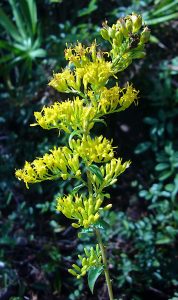
Goldenrod is ruderal. What does that mean? Read the article. Photo by Green Deane
Also seen blooming now is Goldenrod. It is a bit of a treasure hunt and disappointment. The treasure hunt is that one species is better than all the rest for tea, Solidago odora. It does grow here, has an anise flavor, but is hard to find. It’s reported in most counties but is not common. Goldenrod grows in about half of the United States, southwest to northeast. Other Goldenrod species can also be made into tea, perhaps all of them particularly for herbal applications, but they don’t taste anywhere near as good. In fact, after the “Boston Tea Party” of 1773 halted tea imports colonialists drank Goldenrod tea and even exported some to China. It did not catch on. However, every time I see a Goldenrod I pull off a leaf and crush it hoping to detect the tell-tale anise smell. It’s a golden treasure hunt.
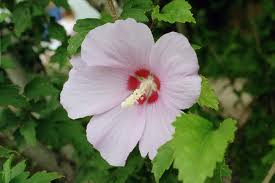
The large blossom of the swamp mallow.
Hibiscus moscheutos is one of my mystery plants and ranges over much of the United States except for the high plains states, the west coast (and my native state of Maine.) The Swamp Rose Mallow is blossoming in damp spots locally particularly along the St. John River. I think its blossoming is more related to the shortening of the days than the weather per se. It has five separate petals united at the base and five green sepals. The blossom lasts only one day. They range from cream with a red or purple center to pale pink. It has a sticky, stringy juice. The question is, as a Hibiscus, are the blossoms edible or other parts? I have never found a reference to edibility. In fact, it seems only one Native American tribe used it medicinally, the Shinnecock who lived on what we now call Long Island. They used it for bladder infections. European settlers, however used the species for a wide variety of ailments. As several writers attest it “abounds with mucilage.” It is always interesting when such a wide-spread plant is rarely mentioned in the ethnobotanical literature. That could mean it wasn’t used, we didn’t ask, or they didn’t tell us. To read more about mallows go here.

Green Deane videos are now available on a USB.
My nine-DVD set of 135 videos has been phased out and replaced by a 150-video USB. The USB videos are the same videos I have on You Tube. Some people like to have their own copy. The USB videos have to be copied to your computer to play. If you want to order the USB go to the DVD/USB order button on the top right of this page or click here. That will take you to an order form. I’d like to thank all of you who ordered the DVD set over the years which required me to burn over 5,000 DVDs individually.

Green Deane Forum
Want to identify a plant? Perhaps you’re looking for a foraging reference? You might have a UFO, an Unidentified Flowering Object, you want identified. On the Green Deane Forum we — including Green Deane and others from around the world — chat about foraging all year. And it’s not just about warm-weather plants or just North American flora. Many nations share common weeds so there’s a lot to talk. There’s also more than weeds. The reference section has information for foraging around the world. There are also articles on food preservation, and forgotten skills from making bows to fermenting food.
 Your donations to upgrade the EatTheWeeds website and fund a book were appreciated. A book manuscript has been turned it. It had 425 articles, 1326 plants and a third of a million words. What it will be when the publisher is done with it next year is unknown. It will be published in the spring of 2023. Writing it took a significant chunk of time out of my life from which I have still not recovered. (Many things got put off.) The next phase is to update all the content on the website between now and publication date. Also note as it states above the 135-video DVD set has been phased out for 150-video USB. Times and formats change. Which reminds me I need to revisit many plants and make some new videos.
Your donations to upgrade the EatTheWeeds website and fund a book were appreciated. A book manuscript has been turned it. It had 425 articles, 1326 plants and a third of a million words. What it will be when the publisher is done with it next year is unknown. It will be published in the spring of 2023. Writing it took a significant chunk of time out of my life from which I have still not recovered. (Many things got put off.) The next phase is to update all the content on the website between now and publication date. Also note as it states above the 135-video DVD set has been phased out for 150-video USB. Times and formats change. Which reminds me I need to revisit many plants and make some new videos.
This is weekly newsletter #471. If you want to subscribe to this free newsletter you can find the sign-up form in the menu at the top of the page.
To donate to the Green Deane Newsletter click here.


Last November 2020, I extracted grape vines (7) from a fallen/rotten pine tree, and pulled them into an opening and wove them around a 20 ft pipe raised 6 feet off the ground, so I suddenly had a vineyard! It was a cheap experiment, since I had no clue what I was doing, or even if those vines produced anything. This new poor man’s vineyard was now fully rooted
in a forest, but the vines were clearly in excellent sunlight.
In the spring 2021, we noticed all the wild grape vines around here (an acre) have blooms, so we assumed it would be a productive grape year, everywhere.
Now, Aug 25 2021, there are no grapes on my property, EXCEPT this quick-vineyard, and the grapes are exceedingly prolific and ALL 7 vines are producing.
I fertilized nothing, since I can’t access the roots.
So dear sir, I ask, what caused these vines to produce so well compared to all others?
Sunlight? My loving attention? Daily visits? I don’t know, but my
wife and I are stunned at the results of a cheap experiment.
Take care, and THanks for THinking!
Mr. Brown
Near Brooker, FL.
Greetings! I just purchased an edible weed book for Central Florida. We live on the south end of Lake Kissimmee and would love to have you out for a visit. We have an airboat to take us deep into the plant areas. It’s an 0540 so it will run dry ground with ease. ( husband has 35 years experience). We are right next to Grape Hammock Fish Camp so you can view us on the map. If you are interested please give us a call. My cell is 321-848-4115.
I’m interested in foraging because I have severe diet restrictions and I do best with a plant based diet and venison for protein. I did try pickerel months ago. I dried it but need some ideas to incorporate this nutrition into my diet. Spanish needle I find is best in soups. I am a beginner but anxious to feel better and heal.
I look forward to hearing from you.